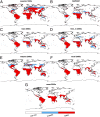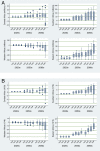Impact of climate change on global malaria distribution
- PMID: 24596427
- PMCID: PMC3948226
- DOI: 10.1073/pnas.1302089111
Impact of climate change on global malaria distribution
Abstract
Malaria is an important disease that has a global distribution and significant health burden. The spatial limits of its distribution and seasonal activity are sensitive to climate factors, as well as the local capacity to control the disease. Malaria is also one of the few health outcomes that has been modeled by more than one research group and can therefore facilitate the first model intercomparison for health impacts under a future with climate change. We used bias-corrected temperature and rainfall simulations from the Coupled Model Intercomparison Project Phase 5 climate models to compare the metrics of five statistical and dynamical malaria impact models for three future time periods (2030s, 2050s, and 2080s). We evaluated three malaria outcome metrics at global and regional levels: climate suitability, additional population at risk and additional person-months at risk across the model outputs. The malaria projections were based on five different global climate models, each run under four emission scenarios (Representative Concentration Pathways, RCPs) and a single population projection. We also investigated the modeling uncertainty associated with future projections of populations at risk for malaria owing to climate change. Our findings show an overall global net increase in climate suitability and a net increase in the population at risk, but with large uncertainties. The model outputs indicate a net increase in the annual person-months at risk when comparing from RCP2.6 to RCP8.5 from the 2050s to the 2080s. The malaria outcome metrics were highly sensitive to the choice of malaria impact model, especially over the epidemic fringes of the malaria distribution.
Keywords: disease modeling; global climate impacts; uncertainty.
Conflict of interest statement
The authors declare no conflict of interest.
Figures



Similar articles
-
Potential future malaria transmission in Odisha due to climate change.Sci Rep. 2022 May 31;12(1):9048. doi: 10.1038/s41598-022-13166-5. Sci Rep. 2022. PMID: 35641573 Free PMC article.
-
Malaria and large dams in sub-Saharan Africa: future impacts in a changing climate.Malar J. 2016 Sep 5;15(1):448. doi: 10.1186/s12936-016-1498-9. Malar J. 2016. PMID: 27592590 Free PMC article.
-
Visualizing the uncertainty in the relationship between seasonal average climate and malaria risk.Sci Rep. 2014 Dec 2;4:7264. doi: 10.1038/srep07264. Sci Rep. 2014. PMID: 25449318 Free PMC article.
-
Modelling climate change and malaria transmission.Adv Exp Med Biol. 2010;673:184-99. doi: 10.1007/978-1-4419-6064-1_13. Adv Exp Med Biol. 2010. PMID: 20632538 Review.
-
Climatic conditions in northern Canada: past and future.Ambio. 2009 Jul;38(5):257-65. doi: 10.1579/0044-7447-38.5.257. Ambio. 2009. PMID: 19714958 Review.
Cited by
-
A century of medical records reveal earlier onset of the malaria season in Haut-Katanga induced by climate change.BMJ Glob Health. 2024 Oct 22;9(10):e015375. doi: 10.1136/bmjgh-2024-015375. BMJ Glob Health. 2024. PMID: 39438071 Free PMC article.
-
Unraveling the urban climate crisis: Exploring the nexus of urbanization, climate change, and their impacts on the environment and human well-being - A global perspective.AIMS Public Health. 2024 Aug 27;11(3):963-1001. doi: 10.3934/publichealth.2024050. eCollection 2024. AIMS Public Health. 2024. PMID: 39416895 Free PMC article. Review.
-
Public health trends in neurologically relevant infections: a global perspective.Ther Adv Infect Dis. 2024 Sep 17;11:20499361241274206. doi: 10.1177/20499361241274206. eCollection 2024 Jan-Dec. Ther Adv Infect Dis. 2024. PMID: 39301451 Free PMC article. Review.
-
Potential impact of climatic factors on malaria in Rwanda between 2012 and 2021: a time-series analysis.Malar J. 2024 Sep 10;23(1):274. doi: 10.1186/s12936-024-05097-5. Malar J. 2024. PMID: 39256741 Free PMC article.
-
Range dynamics of Anopheles mosquitoes in Africa suggest a significant increase in the malaria transmission risk.Ecol Evol. 2024 Jul 31;14(8):e70059. doi: 10.1002/ece3.70059. eCollection 2024 Aug. Ecol Evol. 2024. PMID: 39091337 Free PMC article.
References
-
- Costello A, et al. Managing the health effects of climate change. Lancet. 2009;373(9676):1693–1733. - PubMed
-
- McMichael AJ, et al. Climate change. In: Ezzati M, et al., editors. Comparative Quantification of Health Risks: Global and Regional Burden of Disease Due to Selected Major Risk Factors. Vol 2. Geneva: World Health Organization; 2004. pp. 1543–1649.
-
- Murray CJ, et al. Global malaria mortality between 1980 and 2010: A systematic analysis. Lancet. 2012;379(9814):413–431. - PubMed
-
- WHO . World Malaria Report 2011. Geneva: World Health Organization; 2011. pp. 1–248.
Publication types
MeSH terms
LinkOut - more resources
Full Text Sources
Other Literature Sources
Medical

